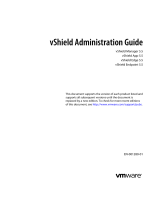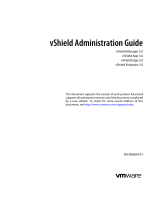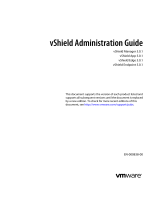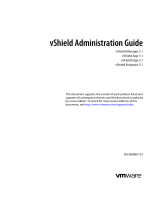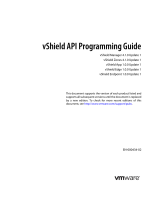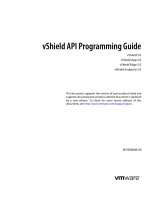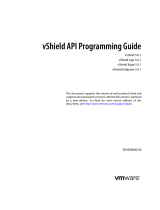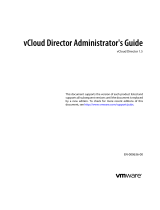Page is loading ...

vShield Installation and Upgrade Guide
vShield Manager 5.1.2
vShield App 5.1.2
vShield Edge 5.1.2
vShield Endpoint 5.1.2
This document supports the version of each product listed and
supports all subsequent versions until the document is replaced
by a new edition. To check for more recent editions of this
document, see http://www.vmware.com/support/pubs.
EN-000868-06

vShield Installation and Upgrade Guide
2 VMware, Inc.
You can find the most up-to-date technical documentation on the VMware Web site at:
http://www.vmware.com/support/
The VMware Web site also provides the latest product updates.
If you have comments about this documentation, submit your feedback to:
Copyright
©
2010 – 2013 VMware, Inc. All rights reserved. This product is protected by U.S. and international copyright and
intellectual property laws. VMware products are covered by one or more patents listed at
http://www.vmware.com/go/patents.
VMware is a registered trademark or trademark of VMware, Inc. in the United States and/or other jurisdictions. All other marks
and names mentioned herein may be trademarks of their respective companies.
VMware, Inc.
3401 Hillview Ave.
Palo Alto, CA 94304
www.vmware.com

Contents
About this Book 5
1
Introduction to vShield 7
vShield Components at a Glance 7
Deployment Scenarios 10
2
Preparing for Installation 13
System Requirements 13
Deployment Considerations 14
3
Installing the vShield Manager 19
Obtain the vShield Manager OVA File 19
Install the vShield Manager Virtual Appliance 19
Configure the Network Settings of the vShield Manager 20
Log In to the vShield Manager User Interface 21
Install 5.1.2a Maintenance Patch 22
Set up vShield Manager 22
Change the Password of the vShield Manager User Interface Default Account 24
Schedule a Backup of vShield Manager Data 24
4
Installing vShield Edge, vShield App, vShield Endpoint, and vShield Data
Security 25
Running vShield Licensed Components in Evaluation Mode 25
Install vShield Component Licenses 26
Install vShield App 26
Installing vShield Edge 28
Installing vShield Endpoint 33
Install vShield Data Security 34
5
Uninstalling vShield Components 35
Uninstall a vShield App Virtual Appliance 35
Uninstall a vShield Edge 35
Uninstall a vShield Data Security Virtual Machine 36
Uninstall a vShield Endpoint Module 36
6
Upgrading vShield 37
Upgrade vShield Manager 37
Upgrade vShield App 42
Upgrade vShield Edge 43
Upgrade vShield Endpoint 43
Upgrade vShield Data Security 44
VMware, Inc.
3

About this Book
This manual, the vShield Installation and Upgrade Guide, describes how to install and configure the
VMware
®
vShield™ system by using the vShield Manager user interface, the vSphere Client plug-in, and
command line interface (CLI). The information includes step-by-step configuration instructions, and suggested
best practices.
Intended Audience
This manual is intended for anyone who wants to install or use vShield in a VMware vCenter environment.
The information in this manual is written for experienced system administrators who are familiar with virtual
machine technology and virtual datacenter operations. This manual assumes familiarity with VMware
Infrastructure 5.x, including VMware ESX, vCenter Server, and the vSphere Client.
VMware Technical Publications Glossary
VMware Technical Publications provides a glossary of terms that might be unfamiliar to you. For definitions
of terms as they are used in VMware technical documentation, go to http://www.vmware.com/support/pubs.
Document Feedback
VMware welcomes your suggestions for improving our documentation. If you have comments, send your
feedback to [email protected].
Technical Support and Education Resources
The following technical support resources are available to you. To access the current version of this book and
other books, go to http://www.vmware.com/support/pubs.
Online and Telephone
Support
To use online support to submit technical support requests, view your product
and contract information, and register your products, go to
http://www.vmware.com/support.
Customers with appropriate support contracts should use telephone support
for the fastest response on priority 1 issues. Go to
http://www.vmware.com/support/phone_support.html.
Support Offerings
To find out how VMware support offerings can help meet your business needs,
go to http://www.vmware.com/support/services.
VMware Professional
Services
VMware Education Services courses offer extensive hands-on labs, case study
examples, and course materials designed to be used as on-the-job reference
tools. Courses are available onsite, in the classroom, and live online. For onsite
pilot programs and implementation best practices, VMware Consulting
VMware, Inc. 5

Introduction to vShield 1
This chapter introduces the VMware
®
vShield™ components you install.
This chapter includes the following topics:
n
“vShield Components at a Glance,” on page 7
n
“Deployment Scenarios,” on page 10
vShield Components at a Glance
VMware vShield is a suite of security virtual appliances built for VMware vCenter Server integration. vShield
is a critical security component for protecting virtualized datacenters from attacks and misuse, and helping
you achieve your compliance-mandated goals.
vShield includes virtual appliances and services essential for protecting virtual machines. vShield can be
configured through a web-based user interface, a vSphere Client plug-in, a command line interface (CLI), and
REST API.
vCenter Server includes vShield Manager. The following vShield packages each require a license:
n
vShield App
n
vShield App with Data Security
n
vShield Edge
n
vShield Endpoint
One vShield Manager manages a single vCenter Server environment and multiple vShield App, vShield Edge,
vShield Endpoint, and vShield Data Security instances.
vShield Manager
The vShield Manager is the centralized network management component of vShield, and is installed as a virtual
appliance on any ESX™ host in your vCenter Server environment. A vShield Manager can run on a different
ESX host from your vShield agents.
Using the vShield Manager user interface or vSphere Client plug-in, administrators install, configure, and
maintain vShield components. The vShield Manager user interface leverages the VMware Infrastructure SDK
to display a copy of the vSphere Client inventory panel, and includes the Hosts & Clusters and Networks
views.
VMware, Inc.
7

vShield App
vShield App is a hypervisor-based firewall that protects applications in the virtual datacenter from network
based attacks. Organizations gain visibility and control over network communications between virtual
machines. You can create access control policies based on logical constructs such as VMware vCenter™
containers and vShield security groups—not just physical constructs such as IP addresses. In addition, flexible
IP addressing offers the ability to use the same IP address in multiple tenant zones to simplify provisioning.
You should install vShield App on each ESX host within a cluster so that VMware vMotion operations work
and virtual machines remain protected as they migrate between ESX hosts. By default, a vShield App virtual
appliance cannot be moved by using vMotion.
The Flow Monitoring feature displays network activity between virtual machines at the application protocol
level. You can use this information to audit network traffic, define and refine firewall policies, and identify
threats to your network.
vShield Edge
vShield Edge provides network edge security and gateway services to isolate a virtualized network, or virtual
machines in a port group, vDS port group, or Cisco Nexus 1000V port group. You install a vShield Edge at a
datacenter level and can add up to ten internal or uplink interfaces. The vShield Edge connects isolated, stub
networks to shared (uplink) networks by providing common gateway services such as DHCP, VPN, NAT, and
Load Balancing. Common deployments of vShield Edge include in the DMZ, VPN Extranets, and multi-tenant
Cloud environments where the vShield Edge provides perimeter security for Virtual Datacenters (VDCs).
Standard vShield Edge Services (Including Cloud Director)
Firewall
Supported rules include IP 5-tuple configuration with IP and port ranges for
stateful inspection for all protocols.
Network Address
Translation
Separate controls for Source and Destination IP addresses, as well as port
translation.
Dynamic Host
Configuration Protocol
(DHCP)
Configuration of IP pools, gateways, DNS servers, and search domains.
Advanced vShield Edge Services
Site-to-Site Virtual
Private Network (VPN)
Uses standardized IPsec protocol settings to interoperate with all major VPN
vendors.
SSL VPN-Plus
SSL VPN-Plus enables remote users to connect securely to private networks
behind a vShield Edge gateway.
Load Balancing
Simple and dynamically configurable virtual IP addresses and server groups.
High Availability
High availability ensures an active vShield Edge on the network in case the
primary vShield Edge virtual machine is unavailable.
vShield Edge supports syslog export for all services to remote servers.
vShield Installation and Upgrade Guide
8 VMware, Inc.

Figure 1-1. Multi-Interface Edge
vShield Edge
MPLS VPN
Internet
Interface 1
Interface 3
Interface 2
Interface 4
Interface 6
Interface 5
DMZ
network
Accounting
network
Marketing
network
Engineering
network
VPN
Load
Balancing
DNS
DHCP
availability
High
vShield Edge
vShield Endpoint
vShield Endpoint offloads antivirus and anti-malware agent processing to a dedicated secure virtual appliance
delivered by VMware partners. Since the secure virtual appliance (unlike a guest virtual machine) doesn't go
offline, it can continuously update antivirus signatures thereby giving uninterrupted protection to the virtual
machines on the host. Also, new virtual machines (or existing virtual machines that went offline) are
immediately protected with the most current antivirus signatures when they come online.
vShield Endpoint installs as a hypervisor module and security virtual appliance from a third-party antivirus
vendor (VMware partners) on an ESX host. The hypervisor scans guest virtual machines from the outside,
removing the need for agents in every virtual machine. This makes vShield Endpoint efficient in avoiding
resource bottlenecks while optimizing memory use.
Chapter 1 Introduction to vShield
VMware, Inc. 9

Figure 1-2. vShield Endpoint Installed on an ESX Host
!
Third-party service virtual appliance deployed
on each host to provide endpoint services
vShield Endpoint hypervisor module
deployed on each host
vShield Data Security
vShield Data Security provides visibility into sensitive data stored within your organization's virtualized and
cloud environments. Based on the violations reported by vShield Data Security, you can ensure that sensitive
data is adequately protected and assess compliance with regulations around the world.
Deployment Scenarios
Using vShield, you can build secure zones for a variety of virtual machine deployments. You can isolate virtual
machines based on specific applications, network segmentation, or custom compliance factors. Once you
determine your zoning policies, you can deploy vShield to enforce access rules to each of these zones.
Protecting the DMZ
The DMZ is a mixed trust zone. Clients enter from the Internet for Web and email services, while services
within the DMZ might require access to services inside the internal network.
You can place DMZ virtual machines in a port group and secure that port group with a vShield Edge. vShield
Edge provides access services such as firewall, NAT, and VPN, as well as load balancing to secure DMZ
services.
A common example of a DMZ service requiring an internal service is Microsoft Exchange. Microsoft Outlook
Web Access (OWA) commonly resides in the DMZ cluster, while the Microsoft Exchange back end is in the
internal cluster. On the internal cluster, you can create firewall rules to allow only Exchanged-related requests
from the DMZ, identifying specific source-to-destination parameters. From the DMZ cluster, you can create
rules to allow outside access to the DMZ only to specific destinations using HTTP, FTP, or SMTP.
vShield Installation and Upgrade Guide
10 VMware, Inc.

Isolating and Protecting Internal Networks
You can use a vShield Edge to isolate an internal network from the external network. A vShield Edge provides
perimeter firewall protection and edge services to secure virtual machines in a port group, enabling
communication to the external network through DHCP, NAT, and VPN.
Within the secured port group, you can install a vShield App instance on each ESX host that the vDS spans to
secure communication between virtual machines in the internal network.
If you utilize VLAN tags to segment traffic, you can use App Firewall to create smarter access policies. Using
App Firewall instead of a physical firewall allows you to collapse or mix trust zones in shared ESX clusters.
By doing so, you gain optimal utilization and consolidation from features such as DRS and HA, instead of
having separate, fragmented clusters. Management of the overall ESX deployment as a single pool is less
complex than having separately managed pools.
For example, you use VLANs to segment virtual machine zones based on logical, organizational, or network
boundaries. Leveraging the Virtual Infrastructure SDK, the vShield Manager inventory panel displays a view
of your VLAN networks under the Networks view. You can build access rules for each VLAN network to
isolate virtual machines and drop untagged traffic to these machines.
Protecting Virtual Machines in a Cluster
You can use vShield App to protect virtual machines in a cluster.
In Figure 1-3, vShield App instances are installed on each ESX host in a cluster. Virtual machines are protected
when moved via vMotion or DRS between ESX hosts in the cluster. Each vApp shares and maintains state of
all transmissions.
Figure 1-3. vShield App Instances Installed on Each ESX Host in a Cluster
Common Deployments of vShield Edge
You can use a vShield Edge to isolate a stub network, using NAT to allow traffic in and out of the network. If
you deploy internal stub networks, you can use vShield Edge to secure communication between networks by
using LAN-to-LAN encryption via VPN tunnels.
vShield Edge can be deployed as a self-service application within VMware Cloud Director.
Chapter 1 Introduction to vShield
VMware, Inc. 11

Common Deployments of vShield App
You can use vShield App to create security zones within a vDC. You can impose firewall policies on vCenter
containers or Security Groups, which are custom containers you can create by using the vShield Manager user
interface. Container-based policies enable you to create mixed trust zones clusters without requiring an
external physical firewall.
In a deployment that does not use vDCs, use a vShield App with the Security Groups feature to create trust
zones and enforce access policies.
Service Provider Admins can use vShield App to impose broad firewall policies across all guest virtual
machines in an internal network. For example, you can impose a firewall policy on the second vNIC of all guest
virtual machines that allows the virtual machines to connect to a storage server, but blocks the virtual machines
from addressing any other virtual machines.
vShield Installation and Upgrade Guide
12 VMware, Inc.

Preparing for Installation 2
This chapter provides an overview of the prerequisites for successful vShield installation.
This chapter includes the following topics:
n
“System Requirements,” on page 13
n
“Deployment Considerations,” on page 14
System Requirements
Before you install vShield in your vCenter Server environment, consider your network configuration and
resources. You can install one vShield Manager per vCenter Server, one vShield App or one vShield Endpoint
per ESX™ host, and multiple vShield Edge instances per datacenter.
Hardware
Table 2-1. Hardware Requirements
Component Minimum
Memory
n
vShield Manager: 8GB allocated, 3GB reserved
n
vShield App: 1GB allocated, 1 GB reserved
n
vShield Edge compact: 256 MB, large: 1 GB, x-large: 8 GB
n
vShield Data Security: 512 MB
Disk Space
n
vShield Manager: 60 GB
n
vShield App: 5 GB per vShield App per ESX host
n
vShield Edge compact and large: 320 MB, lx-Large: 4.4 GB (with 4 GB swap file)
n
vShield Data Security: 6GB per ESX host
vCPU
n
vShield Manager: 2
n
vShield App: 2
n
vShield Edge compact: 1, large and x-Large: 2
n
vShield Data Security: 1
Software
For the latest interoperability information, see the Product Interoperability Matrix at
http://partnerweb.vmware.com/comp_guide/sim/interop_matrix.php.
These are the minimum required versions of VMware products.
n
VMware vCenter Server 5.0 or later
For VXLAN virtual wires, you need vCenter Server 5.1 or later.
VMware, Inc.
13

n
VMware ESX 4.1 or later for each server
For vShield Endpoint, you need VMware ESX 4.1 Patch 3 or later.
For VXLAN virtual wires, you need VMware ESX 5.1 or later.
n
VMware Tools
For vShield Endpoint and vShield Data Security, you must upgrade your virtual machines to hardware
version 7 or 8 and install VMware Tools 8.6.0 released with ESXi 5.0 Patch 3. For more information, see
“Install VMware Tools on the Guest Virtual Machines,” on page 33.
You must install VMware Tools on virtual machines that are to be protected by vShield App.
n
VMware vCloud Director 1.5 or later
n
VMware View 4.5 or later
Client and User Access
n
PC with the VMware vSphere Client
n
If you added ESX hosts by name to the vSphere inventory, ensure that DNS servers have been configured
on the vShield Manager and name resolution is working. Otherwise, vShield Manager cannot resolve the
IP addresses.
n
Permissions to add and power on virtual machines
n
Access to the datastore where you store virtual machine files, and the account permissions to copy files
to that datastore
n
Enable cookies on your Web browser to access the vShield Manager user interface
n
From vShield Manager, port 443 accessible from the ESX host, the vCenter Server, and the vShield
appliances to be deployed. This port is required to download the OVF file on the ESX host for deployment.
n
Connect to the vShield Manager using one of the following supported Web browsers:
n
Internet Explorer 6.x and later
n
Mozilla Firefox 1.x and later
n
Safari 1.x or 2.x
Deployment Considerations
Consider the following recommendations and restrictions before you deploy vShield components.
Deployment Considerations for vShield
This topic describes deployment considerations for vShield components.
Preparing Virtual Machines for vShield Protection
You must determine how to protect your virtual machines with vShield. As a best practice, you should prepare
all ESX hosts within a DRS cluster for vShield App, vShield Endpoint, and vShield Data Security depending
on the vShield components you are using. You must also upgrade your virtual machines to hardware version
7 or 8.
Consider the following questions:
vShield Installation and Upgrade Guide
14 VMware, Inc.

How Are My Virtual Machines Grouped?
You might consider moving virtual machines to port groups on a vDS or a different ESX host to group virtual
machines by function, department, or other organizational need to improve security and ease configuration
of access rules. You can install vShield Edge at the perimeter of any port group to isolate virtual machines from
the external network. You can install a vShield App on an ESX host and configure firewall policies per container
resource to enforce rules based on the hierarchy of resources.
Are My Virtual Machines Still Protected if I vMotion Them to Another ESX Host?
Yes, if the hosts in a DRS cluster are prepared, you can migrate machines between hosts without weakening
the security posture. For information on preparing your ESX hosts, see “Install vShield App,” on page 26.
vShield Manager Uptime
The vShield Manager should be run on an ESX host that is not affected by downtime, such as frequent reboots
or maintenance mode operations. You can use HA or DRS to increase the resilience of the vShield Manager. If
the ESX host on which the vShield Manager resides is expected to require downtime, vMotion the vShield
Manager virtual appliance to another ESX host. Thus, more than one ESX host is recommended.
Communication Between vShield Components
The management interfaces of vShield components should be placed in a common network, such as the vSphere
management network. The vShield Manager requires connectivity to the vCenter Server, ESXi host, vShield
App and vShield Edge instances, vShield Endpoint module, and vShield Data Security virtual machine. vShield
components can communicate over routed connections as well as different LANs.
VMware recommends that you install vShield Manager on a dedicated management cluster separate from the
cluster(s) that vShield Manager manages. Each vShield Manager manages a single vCenter Server
environment.
If the vCenter Server or vCenter Server database virtual machines are on the ESX host on which you are
installing vShield App, migrate them to another host before installing vShield App.
Ensure that the following ports are open:
n
Port 443/TCP from, to, and among the ESX host, the vCenter Server, and vShield Data Security
n
UDP123 between vShield Manager and vShield App for time synchronization
n
443/TCP from the REST client to vShield Manager for using REST API calls
n
80/TCP and 443/TCP for using the vShield Manager user interface and initiating connection to the vSphere
SDK
n
22/TCP for communication between vShield Manager and vShield App and troubleshooting the CLI
Hardening Your vShield Virtual Machines
You can access the vShield Manager and other vShield components by using a web-based user interface,
command line interface, and REST API. vShield includes default login credentials for each of these access
options. After installation of each vShield virtual machine, you should harden access by changing the default
login credentials. Note that vShield Data Security does not include default login credentials.
vShield Manager User Interface
You access the vShield Manager user interface by opening a web browser window and navigating to the IP
address of the vShield Manager’s management port.
The default user account, admin, has global access to the vShield Manager. After initial login, you should
change the default password of the admin user account. See “Change the Password of the vShield Manager
User Interface Default Account,” on page 24.
Chapter 2 Preparing for Installation
VMware, Inc. 15

Command Line Interface
You can access the vShield Manager, vShield App, and vShield Edge virtual appliances by using a command
line interface via vSphere Client console session. To access the vShield Endpoint virtual appliance, refer to the
instructions from the anti-virus solution provider. You cannot access the vShield Data Security virtual machine
by using the command line interface.
Each virtual appliance uses the same default username (admin) and password (default) combination as the
vShield Manager user interface. Entering Enabled mode also uses the password default.
For more on hardening the CLI, see the vShield Command Line Interface Reference .
REST Requests
All REST API requests require authentication with the vShield Manager.
Using Base 64 encoding, you identify a username-password combination in the following format:
username:password. You must use a vShield Manager user interface account (username and password) with
privileged access to perform requests. For more on authenticating REST API requests, see the vShield API
Programming Guide.
Deployment Considerations for vShield App
VMware recommends that you analyze your vCenter Server environment and determine whether your want
to protect the entire environment or certain clusters only.
If you decide to protect specific clusters, you must prepare the entire cluster and install vShield App on all ESX
hosts in those clusters. If you install vShield App only on some hosts in a cluster, there is a chance that vMotion
can move virtual machines from a protected to an unprotected host thus compromising the security of your
network.
Ensure that you install vShield App in your environment during a maintenance window. The total install time
may vary depending on your environment and the number of hosts in each cluster, but you must complete
installing vShield App on all desired clusters before resuming normal operations.
After installation, VMware recommends that you enable vSphere HA and set the cluster feature to VM and
Application Monitoring on the clusters where you installed vShield App. This feature monitors the vShield
App and triggers a restart if it fails, which minimizes the vShield App outage. For more information on this
feature, see vSphere Availability.
VMware recommends that you let vShield App run during normal operations and use the vShield App Flow
Monitoring tool for baseline knowledge of the traffic flowing in and out of your virtual network. You can then
add rules according to the needs of your network.
Enabling the SpoofGuard feature of vShield App allows you to authorize the IP addresses reported by VMware
Tools, and alter them if necessary to prevent spoofing. Depending on the SpoofGuard mode you choose,
vShield App either automatically trusts IP assignments on their first use or requires you to manually approve
IP assignments before use. However, be aware that the IP address of a virtual machine may change when the
DHCP server renews a lease or is rebooted. This means that you must approve the new or renewed IP address
if the SpoofGuard feature is enabled.
Becoming familiar with the flow monitoring and SpoofGuard features before installing vShield App will enable
you to configure vShield App in the most secure way possible. For more information on these features, see the
vShield Administration Guide.
vShield Installation and Upgrade Guide
16 VMware, Inc.

Deployment Considerations for vShield Edge
Before installing vShield Edge, you must become familiar with your network topology. vShield Edge can have
multiple interfaces, but you must connect at least one internal interface to a portgroup or VXLAN virtual wire
before you can deploy the vShield Edge.
The uplink interface provides connectivity to the outside world. You must have created and configured a port
group or VXLAN virtual wire that has external connectivity. You must also have a port group with virtual
machines to which you can connect the internal interface. Determine the IP addresses and subnets to be
provided for these interfaces. Also think about the services that you should enable and configure after installing
vShield Edge. For more information on vShield Edge services, see the vShield Administration Guide.
After you install vShield Edge and before you configure vShield Edge services, virtual machines in that port
groups(s) may lose network connectivity. To avoid this issue, you may create a new port group, install and
configure vShield Edge on it, and then move virtual machines to the port group.
Be aware that the default vShield Edge firewall policy blocks all incoming traffic, so you must add allow rules
as required.
Chapter 2 Preparing for Installation
VMware, Inc. 17

vShield Installation and Upgrade Guide
18 VMware, Inc.

Installing the vShield Manager 3
VMware vShield provides firewall protection, traffic analysis, and network perimeter services to protect your
vCenter Server virtual infrastructure. vShield virtual appliance installation has been automated for most virtual
datacenters.
The vShield Manager is the centralized management component of vShield. You use the vShield Manager to
monitor and push configurations to vShield App, vShield Endpoint, and vShield Edge instances. The vShield
Manager runs as a virtual appliance on an ESX host.
Installing the vShield Manager is a multistep process. You must perform all of the tasks that follow in sequence
to complete vShield Manager installation successfully.
To enhance your network security posture, you can obtain licenses for vShield App, vShield Endpoint, and
vShield Edge.
This chapter includes the following topics:
n
“Obtain the vShield Manager OVA File,” on page 19
n
“Install the vShield Manager Virtual Appliance,” on page 19
n
“Configure the Network Settings of the vShield Manager,” on page 20
n
“Log In to the vShield Manager User Interface,” on page 21
n
“Install 5.1.2a Maintenance Patch,” on page 22
n
“Set up vShield Manager,” on page 22
n
“Change the Password of the vShield Manager User Interface Default Account,” on page 24
n
“Schedule a Backup of vShield Manager Data,” on page 24
Obtain the vShield Manager OVA File
The vShield Manager virtual machine is packaged as an Open Virtualization Appliance (OVA) file, which
allows you to use the vSphere Client to import the vShield Manager into the datastore and virtual machine
inventory.
Install the vShield Manager Virtual Appliance
You can install the vShield Manager virtual machine on an ESX host in a cluster configured with DRS.
With vShield 5.0 and later, you can install the vShield Manager in a different vCenter than the one that the
vShield Manager will be interoperating with. A single vShield Manager serves a single vCenter Server
environment.
VMware, Inc.
19

The vShield Manager virtual machine installation includes VMware Tools. Do not attempt to upgrade or install
VMware Tools on the vShield Manager.
Prerequisites
You must have been assigned the Enterprise Administrator or vShield Administrator role .
Procedure
1 Log in to the vSphere Client.
2 Create a port group to home the management interface of the vShield Manager.
The vShield Manager management interface, vCenter Server, and ESXi hosts must be reachable by all
future vShield Edge, vShield App, and vShield Endpoint instances.
3 Select File > Deploy OVF Template.
4 Click Browse to locate the folder on your PC that contains the vShield Manager OVA file.
5 Complete the installation.
The vShield Manager is installed as a virtual machine in your inventory.
6 Power on the vShield Manager virtual machine.
What to do next
The default CPU for vShield Manager 5.1 is 2 vCPU. For vShield Manager to work with vSphere Fault
Tolerance, you must set the CPU to 1 vCPU.
Configure the Network Settings of the vShield Manager
You must use the command line interface (CLI) of the vShield Manager to configure an IP address, identify
the default gateway, and set DNS settings.
You can specify up to two DNS servers that the vShield Manager can use for IP address and host name
resolution. DNS is required if any ESX host in your vCenter Server environment was added by using the
hostname (instead of IP address).
Procedure
1 Right-click the vShield Manager virtual machine and click Open Console to open the command line
interface (CLI) of the vShield Manager.
The booting process might take a few minutes.
2 After the manager login prompt appears, log in to the CLI by using the user name admin and the password
default.
3 Enter Enabled mode by using the password default.
manager> enable
Password:
manager#
vShield Installation and Upgrade Guide
20 VMware, Inc.
/




